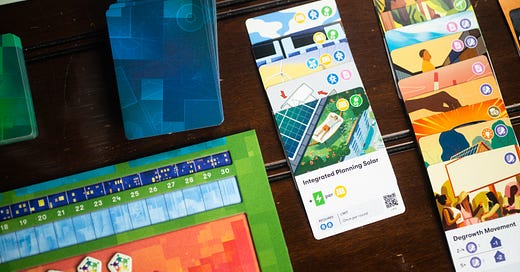Mitigating quarterbacking in cooperative games
A persistent issue in cooperative board gaming has led to several solutions.
If you have much experience with cooperative games, you’ve almost certainly come across a problem often described as ‘quarterbacking,’ which describes when one player takes implicit control of the team’s decisions. It is a phenomenon that is well-documented and well-discussed, and it is unique to cooperative games, as it relies on players having shared ends to which they’re aiming. It’s also a problem that’s been addressed by designers of cooperative games, with solutions coming in several different forms over the last decade.
The award-winning Daybreak is a cooperative game about battling the effects of climate change, and while it might seem a bit beefy if you look at the big stacks of cards, you’ll quickly learn it doesn’t have to be intimidating. While not every cooperative game provides a good on-ramp for new players, Daybreak does better in this regard than some of the more asymmetric games that have emerged, like the incredible Spirit Island (Reuss, 2017) in that all players are fundamentally playing the same game. It also retains player agency better than a game like Pandemic (Leacock, 2008) in that you do have player-specific information to which only you have close view, reducing issues with a single player guiding the team to victory. Both of those games provide plenty of demonstrable value, but both aspects can provide difficulties for new players.
One of the keys in a great design is player agency: You should feel like you’re making decisions that materially impact your experience. Whether that’s pushing your luck in game like Can’t Stop (Sackson, 1980) or building your farm in Agricola (Rosenberg, 2007), a good game, whether relying on rolls of the dice or being fully player-driven, imbues players with agency. While that’s still wholly present in a game like Pandemic, social conditions can lessen that agency. Whether it’s described as an “alpha player problem” (like the alpha wolf myth) or quarterbacking, one player taking control of a less-experienced player’s actions leads to an inherent decrease in player agency.
In Daybreak, each player has in front of them a selection of cards to help them build their particular world-saving engine. While that hand of cards is public, it’s all distant enough from the other players that their focus stays on their area. It’s an interesting effect, because it’s not that anything about Daybreak is private: Everything in this game is visible by each player equally. But because the cards to which you’re paying attention are in front of you, and the text isn’t easily legible across a table, each player’s focus is more naturally in their area. It’s an excellent illustration of what game designer Scott Rogers calls “the six zones of play”.
Those six zones, enumerated as (1) a player’s dominant hand, (2) a player’s non-dominant hand, (3) the tableau, (4) the board or shared space, (5) the sideboard, and (6) the rule book, create an important consideration here. With no cards held directly in hand, Daybreak has players focused on their tableau and the shared board, with the other players’ tableaus being a distant consideration. A podcast episode of Ludology, released in 2019, discusses the topic in some depth. In this case, zone three consists both of the player’s in-game tableau and the player’s public hand of cards, so ‘the tableau’ can be a little confusing as a term.
It’s a novel way to solve a common problem in cooperative games. By putting information outside of a player’s zone of play, the game puts domineering players in a difficult position, but it’s not an impossible one. They could lean over the table, check out their teammates’ cards, and make suggestions (or, worse, demands) on how to play. Keeping things in zone three is not the only aspect of this game that mitigates that particular threat. Daybreak has one more trick up its sleeve, and it’s what delivers the game best: Play happens simultaneously. Yes, the entire game is made of public decisions, and the totality of a player’s decision-making happens based on information shared with the team, but this is a sort of forcing function. This drives players’ behavior toward completing their own tasks, lest an hour-long game turn into a six-hour game.
This mechanical quality also drives the game’s themes, a topic I wrote about in April last year. I won’t get too deep into that here, but simply put, consistent success will come as players find ways to communicate their own situation and what they can contribute to the larger whole, much as you’d expect from a global concern like the climate crisis. It’s one of the ways the game still manages to surprise me, the way they extend metaphor into every inch of the gameplay.
Designed by Matt Leacock and Matteo Menapace, illustrated by Mads Berg, and published by CMYK. Daybreak won the 2024 Kennerspiel das Jahres prize.
This is hardly the only way to approach solving that quarterbacking problem in cooperative games. From games played at a frenetic real-time pace to games played in silence, many have solved these problems differently. They are mechanical approaches you can find in games cooperative and competitive alike, but we will focus here on the ones that work particularly well in cooperative gaming.
Among the games that use real-time interactions and simultaneous play, Now Boarding is perhaps my favorite. It’s a cooperative game in which each player is running an airline, ferrying passengers from location to location until they reach their destination — or before they get too angry at having to wait. The real-time game is punctuated by between-round planning sessions, which allow players to coordinate their actions somewhat, but it’s done with limited information. Any planning becomes slightly theoretical, hedged upon new passengers arriving that might bring in a higher rate. And while Now Boarding isn’t a dexterity game, there are moments over the course of play that you’ll be maneuvering your hands around other players’ hands, awkwardly trying to move your plane to the next destination before time expires. There simply isn’t time here for a single player to rule proceedings, and if a player tries, they’ll certainly run out of time. Designed by Tim Fowers, illustrated by Ryan Goldsberry, and published by Fowers Games.
Some other notable real-time cooperative games I enjoy include — but certainly aren’t limited to:
Magic Maze and its related games, in which you’re moving around a map as a sand timer ticks down — but you can only move figures in a specified direction, with the totality of directions spread around the table. Designed by Kasper Lapp, illustrated by Gyom, and published by Sit Down!
Mental Blocks is a puzzle game in which you’re trying to construct a three-dimensional object using colored blocks, but each player has only a limited view of the final object. Designed by Jonathan Gilmour-Long and Micah Saywer, illustrated by Katie Khau, and published by Pandasaurus Games.
Hey Yo is a simple card game in which you’re all trying to play cards to a rhythm, but you won’t have time between beats to coordinate — you’ve just got to play a card. Designed by Takashi Saito, illustrated by Jun Sasaki and Hayashi Sasaki, and published by Oink Games.
Designers also often skew toward hidden, personal information. While this can be harnessed to reduce quarterbacking, it’s also often at the heart of a game’s concept. While a real-time game could be played slowly instead of quickly, removing hidden information from a cooperative game might torpedo its feasibility as a game altogether. Consider The Mind (Warsch, 2018), famously about playing cards in ascending order. If each card was visible or could be otherwise communicated, it would be a trivial experience. The Crew (Sing, 2019) would retain some of its best qualities in sequencing tricks, but the experience would be decidedly simple through much of the game’s campaign. The Gang (Cooper and Heath, 2024) would be an exercise in ensuring everyone at the table understood the relative ranking of poker hands.
Asymmetric player abilities, like those at the heart of Spirit Island, further expand on approaches for cooperative games, but this neatly ties back to that ‘zone three’ concept we discussed above. In Spirit Island, each player takes on the role of an angry spirit fighting back against colonizers to protect the titular island and its inhabitants. The roles are more than varied — they’re fundamentally different in some key ways. While an experienced player might be offer advice and instruction to a less experienced player, or to a player who simply hasn’t played with a specific role, it’s helpful that the player is looking in their tableau zone, not in a shared zone. This mitigates the quarterbacking problem somewhat on its own, and it’s seen through by making the cards in a player’s hand private information. While the game itself isn’t immune to the quarterbacking problem, much like Daybreak, the game throws up roadblocks. You can get around them, but it’s going to take time. Designed by R. Eric Reuss, illustrated an incredible number of artists, and published by Greater Than Games.
This is, of course, not an exhaustive list. There are many ways designers have tried to mitigate a single player taking control of a game. It’s doubly interesting to me, as it’s rarely a phenomenon of the game’s design and more of the game’s players. As a result, some designers don’t account for the problem at all. Certainly, some of the designers mentioned here weren’t looking to design a game to counteract that trend, instead just being focused on designing a great cooperative game. Neither approach is more right than the other, but humans are messy, unusual beings, and we often get in our way. We step in front of the fun, depriving others of the decision-making process. Is this a natural state of enthusiasm for some? Is it a symptom of a broader concern? These are questions I just can’t answer — but thankfully, some designers have given us games that account for the human condition.
Thank you, as always, for reading and subscribing. I hope you’re well! I’ve played a few very interesting games lately — Trickarus (Cannon, 2024), a trick-taking spin on the tale of Icarus; Tip of the Diceberg (Barron, 2025); and Greasy Spoon (Ross, 2023/2025) all take trick-taking and climbing in interesting new directions. Maybe that’s what I’ll be writing about next week. I don’t quite know yet. Whatever it is, I hope you’ll join me.











